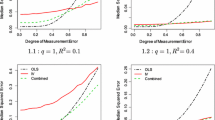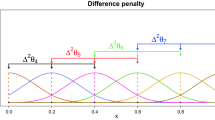Abstract
Under general parametric models, Claeskens and Hjort (J Am Stat Assoc 98:900–916, 2003) proposed a focused information criterion for model selection which emphasizes the accuracy of estimation for particular parameters of interest. This paper extends their framework to include a semi-parametric varying-coefficient partially linear model when covariates in both the parametric and the non-parametric parts are subject to measurement errors. We allow the covariance matrices of the measurement errors to be unknown and be estimated by replicated observations. Also, we derive the asymptotic properties of the frequentist model average estimator for the model in consideration, which generalizes the results obtained by Wang et al. (Electron J Stat 6:1017–1039, 2012). In addition to asymptotic properties, finite sample performance of the proposed methods are examined in a simulation study, and a data set obtained from Continuing Survey of Food Intakes by Individuals conducted by the U.S. Department of Agriculture’s (CSFII) is considered.
Similar content being viewed by others
References
Akaike H. (1973). Information theory and an extension of the maximum likelihood principle. In: Petrov BN, źaki FC (eds). 2nd International symposium on information theory. Akademiai Kaidó, Budapest, pp 267–281
Buckland ST, Burnham KP, Augustin NH (1997) Model selection: an integral part of inference. Biometrics 53:603–618
Carroll RJ, Ruppert D, Stefanski LA, Crainiceanu CM (2006) Measurement error in nonlinear models: a modern perspective, 2nd edn. Chapman and Hall, New York
Claeskens G, Carroll RJ (2007) An asymptotic theory for model selection inference in general semiparametric problems. Biometrika 94:249–265
Claeskens G, Hjort NL (2003) The focused information criterion. J Am Stat Assoc 98:900–916
Claeskens G, Hjort NL (2008) Model selection and model averaging. Cambridge University Press, New York
Craven P, Wahba G (1979) Smoothing noisy data with spline functions. Numerische Mathematik 31:377–403
Danilov D, Magnus JR (2004) On the harm that ignoring pretesting can cause. J Econom 122:27–46
Fan J, Huang T (2005) Profile likelihood inferences on semiparametric varying-coefficient partially linear models. Bernoulli 11:1031–1057
Hjort NL, Claeskens G (2003) Frequestist model average estimators. J Am Stat Assoc 98:879–899
Hjort NL, Claeskens G (2006) Focused information criteria and model averaging for the Cox hazard regression model. J Am Stat Assoc 101:1449–1464
Liang H, Härdle W, Carroll RJ (1999) Estimation in a semiparametric partially linear errors-in-variables model. Annals Stat 27:1519–1535
Magnus JR, Durbin J (1999) Estimation of regression coefficients of interest when other regression coefficients are of no interest. Econometrica 67:639–643
Mallows CL (1973) Some comments on \(C_p\). Technometrics 15:661–675
Peña, E. A., Wu, W., Piegorsch, W. W., West, R. W., and An, L. (2013). Model selection and estimation with quantal-response data in benchmark risk assessment. Tech rep
Schomaker M (2012) Shrinkage averaging estimation. Stat Pap 53(4):1015–1034
Schomaker M, Heumann C (2014) Model selection and model averaging after multiple imputation. Comput Stat Data Anal 71:758–770
Schomaker M, Wan ATK, Heumann C (2010) Frequentist model averaging with missing observations. Comput Stat Data Anal 54:3336–3347
Schwarz G (1978) Estimating the dimension of a model. Annals Stat 6:461–464
Stone M (1974) Cross-validatory choice and assessment of statistical predictions. J R Stat Soc Ser B (Methodological) 36:111–147
Wang H, Zou G (2012) Frequentist model averaging estimation for linear errors-in-variables model. J Syst Sci Math Sci Chin Ser 32:1–14
Wang H, Zou G, Wan ATK (2012) Model averaging for varying-coefficient partially linear measurement error models. Electron J Stat 6:1017–1039
Wang H, Zou G, Wan AT-K (2013) Adaptive lasso for varying-coefficient partially linear measurement error models. J Stat Plan Inference 143:40–54
You J, Chen G (2006) Estimation of a semiparametric varying-coefficient partially linear errors-in-variables model. J Multivar Anal 97:324–341
You J, Zhou Y, Chen G (2006) Corrected local polynomial estimation in varying-coefficient models with measurement errors. Can J Stat 34:391–410
Zhang X, Liang H (2011) Focused information criterion and model averaging for generalized additive partial linear models. Annals Stat 39:174–200
Zhang X, Wan ATK, Zhou SZ (2012) Focused information criteria, model selection and model averaging in a tobit model with a non-zero threshold. J Bus Econ Stat 30:132–142
Acknowledgments
We are very grateful to the editor and two referees for their constructive comments and suggestions.
Author information
Authors and Affiliations
Corresponding author
Appendix
Appendix
The following conditions are required for the proof.
-
1.
The random variable \(T\) has bounded support \(\varvec{\Omega }\), and its density \(f\) is Lipschitz continuous and bounded away from 0 on its support.
-
2.
For each \(T\in \varvec{\Omega }\), the \(r\times r\) matrix \(\mathbf {E}(ZZ^{\top }|T)\) is non-singular, and each element of \(\mathbf {E}(ZZ^{\top }|T)\), \(\mathbf {E}(XX^{\top }|T)\) or \(\mathbf {E}(ZX^{\top }|T)\) is Lipschitz continuous.
-
3.
There exists some \(\epsilon >2\) such that \(\mathbf {E} \Vert X\Vert ^{2\epsilon }<\infty \), \(\mathbf {E} \Vert Z\Vert ^{2\epsilon }<\infty \), \(\mathbf {E} \Vert U\Vert ^{2\epsilon }<\infty \), \(\mathbf {E} \Vert V\Vert ^{2\epsilon }<\infty \) and \(\mathbf {E} \Vert \varepsilon \Vert ^{2\epsilon }<\infty \), and \(\rho <2-\epsilon ^{-1}\) such that \(nh^{2\rho -1}\rightarrow \infty \) and \(nh^8\rightarrow 0\).
-
4.
\(\alpha _j(T),j=1,\ldots ,r\), is twice continuously differentiable in \(T\in \varvec{\Omega }\).
-
5.
\(K(\cdot )\) is a symmetric density with compact support.
Proof of Theorem 1
Let \(\hat{U}_i =({\bar{\psi }}_{i}\mathbf {U})^{\top }\), \(\hat{\varepsilon }_i={\bar{\psi }}_{i}\varvec{\varepsilon }\) and \(\bigtriangledown =\widetilde{\bar{\mathbf {W}}}^{\top }\widetilde{\bar{\mathbf {W}}}-nJ^{-1}\hat{\Sigma }_u\). Then from Eq. (4), we have
From the expressions of \(\hat{\bar{Y}}_i\), \(\hat{\bar{W}}_i\), \(\hat{\bar{U}}_i\) and \(\hat{\bar{\varepsilon }}_i\), we obtain
Hence,
Applying the method used in Fan and Huang (2005) provides that, uniformly in \(T\), \( \hat{\bar{W}}_i^{\top }=(\bar{\varvec{\zeta }}_{i}^{\top },\;0)\left\{ (\mathcal {D}^{\bar{\zeta }}_{t_i})^{\top }\Omega _{t_i}\mathcal {D}^{\bar{\zeta }}_{t_i}-{\bar{\phi }}_{t_i}\right\} ^{-1}(\mathcal {D}^{\bar{\zeta }}_{t_i})^{\top }\Omega _{t_i}\mathbf {W}={\bar{\zeta }}_{i}^{\top }\{\mathbf {E}(Z_iZ_i^{\top }|T_i)\}^{-1}\mathbf {E}(Z_iX_i^{\top }|T_i)\{1+O_P(c_n)\},\) where \(c_n=\{\log (1/h)/(nh)\}^{1/2}+h^2\). In addition, since \(\{\mathbf {E}(\bar{W}_iZ_i^{\top }|T_i)\}^{\top }=\mathbf {E}(Z_i\bar{W}_i^{\top }|T_i)\) and \(\theta _{{\mathrm{true}}}=\theta _0+(0^{\top },\delta ^{\top })^{\top }/\sqrt{n}\), we have
The application of the Central Limit Theorem yields \(\sum _{i=1}^n[\mathbf {E}(\bar{W}_iZ_i^{\top }|T_i)\{\mathbf {E}(Z_iZ_i^{\top }|T_i)\}^{-1}Z_i](\varepsilon _i-\bar{U}_i^{\top }\theta _0)=O_P(\sqrt{n})\). Therefore, \(J_2=O_P(\sqrt{n}c_n)=o_P(\sqrt{n})\). Similarly \(J_3=o_P(\sqrt{n})\), and \(J_4=o_P(\sqrt{n})\). Using Slutsky’s Theorem and recognizing that \(\bigtriangledown /n=B_n\overset{p}{\longrightarrow }B\) as \(n\rightarrow \infty \), we obtain
The above results together with Eq. (5) and the Continuous Mapping Theorem finish the proof. \(\square \)
Proofs of Theorem 2 and Theorem 3
With the result in Theorem 1, they can be proved using approaches similar to those used in the proof of Theorem 1 and Theorem 2 in Wang et al. (2012), respectively. We skip the details here to save space. \(\square \)
Rights and permissions
About this article
Cite this article
Wang, H.Y., Chen, X. & Flournoy, N. The focused information criterion for varying-coefficient partially linear measurement error models. Stat Papers 57, 99–113 (2016). https://doi.org/10.1007/s00362-014-0645-z
Received:
Revised:
Published:
Issue Date:
DOI: https://doi.org/10.1007/s00362-014-0645-z




